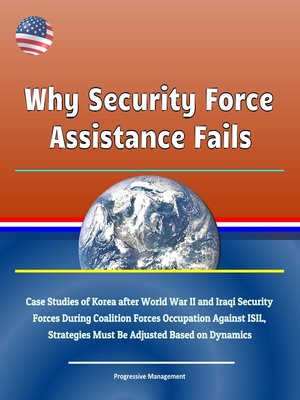Why Security Force Assistance Fails
ebook ∣ Case Studies of Korea after World War II and Iraqi Security Forces During Coalition Forces Occupation Against ISIL, Strategies Must Be Adjusted Based on Dynamics

Sign up to save your library
With an OverDrive account, you can save your favorite libraries for at-a-glance information about availability. Find out more about OverDrive accounts.
Find this title in Libby, the library reading app by OverDrive.



Search for a digital library with this title
Title found at these libraries:
| Library Name | Distance |
|---|---|
| Loading... |
This report has been professionally converted for accurate flowing-text e-book format reproduction. The nature of U.S. armed conflict in the twenty-first century has seen a decrease in the use of force to exclusively achieve military end states in support of policy objectives. This forces military practitioners and policy makers to reconcile the differences between the military's traditional role of conducting combined arms maneuver and the recent trends of large-scale stability operations. During a period of fiscal austerity while the U.S. military is relying on a rotational presence of forces to shape and deter conflict, the necessity of conducting security working by, with, and through U.S. partners and allies remains at the forefront.
Effective security force assistance requires a convergence of regional interests between the United States and its partnered nations. It also requires a balance of capabilities to face both internal and external threats. After World War II, the United States established a group of advisors assigned to train and advise Korean police and army units, focusing on counter-guerilla and riot control techniques aimed at defeating Communist insurgent threats; South Korea then found itself embroiled in a conventional civil war time period. Iraqi Security Forces found themselves in a similar predicament, fighting a decentralized insurgency during the Coalition Forces occupation to then facing ISIL, an insurgent organization capable of fighting at the battalion level.
National policies, along with the strategies that implement them, are not static and are subject to change based on internal and regional dynamics. Effective security force assistance requires military practitioners and policy makers to adjust their strategies according to the environment. This requires planners to anticipate both internal and external threats in order to ensure a more sustainable outcome.
Contents: 1. Introduction 2. Terminology 3. Security Cooperation Overview 4. Methodology 5. Korea 1945-1950 6. Iraq 7. Conclusion
This new vision of the Army Operating Concept reveals an emphasis on Phase 0 Shape and Phase 1 Deter operations. By maintaining a presence forward throughout the Combatant Commands, the operating concept suggests Army forces will have already established inroads with partners and allies, easing a transition to Phase II Seize the Initiative should the need arise. Building partnership capacity through security assistance activities such as foreign internal defense, counterinsurgency, foreign military sales, or security cooperation aids a decline of forward basing for the United States and assures allies of U.S. commitment to doing its part in deterring and winning conflict. The operating concept also acknowledges that coalition warfare will continue to be an integral part of U.S. conflict in establishing legitimacy and providing additional power projection capability.
However, conducting security assistance activities as a means to prevent or to intervene in conflict is by no means a fully proven concept. Aid in the form of money and training host nation forces is difficult, time-consuming, and requires an appreciation of the strategic picture as opposed to just the immediate operational threat. After World War II, the United States established a group of advisors assigned to train and advise Korean police and army units, focusing on counter-guerilla and riot control techniques aimed at defeating Communist insurgent threats; South Korea then found itself embroiled in a conventional civil war time period. Fighting a decentralized insurgency and settling sectarian scores consumed the Iraqi government, which is now facing an...







